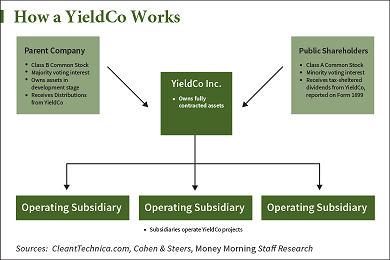If you follow alternative energy stocks, the question of "What is a YieldCo?" has probably come up at some point over the past couple of years.
That's because YieldCos have become popular in the green energy industry as a way to raise relatively cheap capital to finance new projects while setting up a revenue stream from finished projects.
NRG Energy Inc. (NYSE: NRG) launched the solar industry YieldCo trend in July 2013 with NRG Yield Inc. (NYSE: NYLD). A half dozen more have followed, with another in the pipeline. That one's a joint venture of First Solar Inc. (Nasdaq: FSLR) and SunPower Corp. (Nasdaq: SPWR).
Solar YieldCos alone have raised more than $8 billion in capital over the past 18 months, a figure expected to triple over the next few years.
While the term "YieldCo" may be new to a lot of investors, how one works should not be.
YieldCos have much in common with the master limited partnerships (MLPs) popular in the oil and gas industry or the real estate investment trusts (REITS) favored by the commercial real estate industry.
So what is a YieldCo, exactly?
What Is a YieldCo?

YieldCos are separate companies created by a parent company for the purpose of operating finished projects. This new company has an IPO and becomes a publicly traded stock.
In the solar industry, YieldCos typically operate solar farms, but the company can also own other kinds of energy assets. The sale of solar energy generates cash flow that is used to pay out a dividend, usually in the 3% to 6% range.
That's a bit lower than MLPs, which pay about 6% on average. The main reason for the difference is that YieldCos are taxed as corporations, not partnerships. So the profits of a YieldCo are taxed at the corporate level. (Only the distributions of MLPs are taxed.)
Instead, YieldCos are structured to reduce taxes as much as possible by matching the cash flow from operations with losses from depreciation and expenses.
This structure also means that shareholders in a YieldCo receive a 1099 dividend form at tax time instead of the slow-to-arrive and more cumbersome K-1 form that owners of MLPs receive.
But YieldCos offer these other advantages - which are particularly good for income investors ...
What Is a YieldCo? A Good Income and Growth Play
YieldCos are a great source of low-risk, moderate-yield income. But they also offer the potential for stock appreciation.
For instance, the more straightforward tax structure of a YieldCo opens it up to a wider group of large investors. Many mutual funds locked out of MLPs have no problem buying YieldCos. Such additional buyers with deep pockets is a positive for the stock price.
And that's not the only catalyst built into the Yieldco structure.
[epom key="ddec3ef33420ef7c9964a4695c349764" redirect="" sourceid="" imported="false"]
You see, as time goes by, the assets in a YieldCo reach the end of their depreciation cycle - and cease to provide tax benefits. This means the parent company periodically needs to seed the YieldCo with fresh projects, or "drop-downs."
That not only maintains the YieldCo's tax advantages, but fuels growth of the dividend, which in turn makes the YieldCo stock more appealing to investors.
This all makes sense for the parent company as well. It raises cash with the IPO as well as the drop-downs of assets transferred to the YieldCo over time. And because it retains a large stake in the YieldCo, the parent also receives a large portion of the dividends.
All of that money supplies capital to build new projects, and the cycle starts over again.
While the future looks bright for YieldCos, one possible dark cloud is rising interest rates. That could raise the yield on other income investments, making them more attractive. Investors might be lured away from YieldCos in such a scenario, hurting YieldCo stock prices.
But given the U.S. Federal Reserve's hesitance to upset the U.S. economy or the markets, it should be a long time before higher interest rates pose a threat to YieldCos.
Follow me on Twitter @DavidGZeiler.
More Solar Power Profits: First Solar stock has been slammed recently over a missed earnings report and a tough downgrade from RBC Capital. But when you dig deeper, it's clear that First Solar has a solid strategy for dealing with shifts in the solar industry. FSLR stock today is no disaster - it's a buying opportunity.
About the Author
David Zeiler, Associate Editor for Money Morning at Money Map Press, has been a journalist for more than 35 years, including 18 spent at The Baltimore Sun. He has worked as a writer, editor, and page designer at different times in his career. He's interviewed a number of well-known personalities - ranging from punk rock icon Joey Ramone to Apple Inc. co-founder Steve Wozniak.
Over the course of his journalistic career, Dave has covered many diverse subjects. Since arriving at Money Morning in 2011, he has focused primarily on technology. He's an expert on both Apple and cryptocurrencies. He started writing about Apple for The Sun in the mid-1990s, and had an Apple blog on The Sun's web site from 2007-2009. Dave's been writing about Bitcoin since 2011 - long before most people had even heard of it. He even mined it for a short time.
Dave has a BA in English and Mass Communications from Loyola University Maryland.



